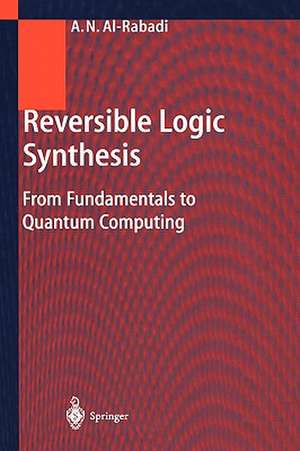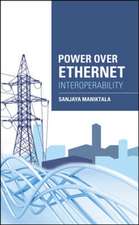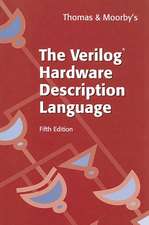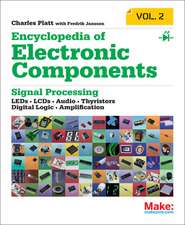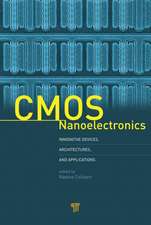Reversible Logic Synthesis: From Fundamentals to Quantum Computing
Autor Anas N. Al-Rabadien Limba Engleză Hardback – 8 sep 2003
| Toate formatele și edițiile | Preț | Express |
|---|---|---|
| Paperback (1) | 648.24 lei 43-57 zile | |
| Springer Berlin, Heidelberg – 5 oct 2012 | 648.24 lei 43-57 zile | |
| Hardback (1) | 654.77 lei 43-57 zile | |
| Springer Berlin, Heidelberg – 8 sep 2003 | 654.77 lei 43-57 zile |
Preț: 654.77 lei
Preț vechi: 770.31 lei
-15% Nou
Puncte Express: 982
Preț estimativ în valută:
125.29€ • 131.16$ • 103.67£
125.29€ • 131.16$ • 103.67£
Carte tipărită la comandă
Livrare economică 07-21 aprilie
Preluare comenzi: 021 569.72.76
Specificații
ISBN-13: 9783540009351
ISBN-10: 3540009353
Pagini: 456
Ilustrații: XXIII, 427 p.
Dimensiuni: 155 x 235 x 30 mm
Greutate: 0.82 kg
Ediția:2004
Editura: Springer Berlin, Heidelberg
Colecția Springer
Locul publicării:Berlin, Heidelberg, Germany
ISBN-10: 3540009353
Pagini: 456
Ilustrații: XXIII, 427 p.
Dimensiuni: 155 x 235 x 30 mm
Greutate: 0.82 kg
Ediția:2004
Editura: Springer Berlin, Heidelberg
Colecția Springer
Locul publicării:Berlin, Heidelberg, Germany
Public țintă
ResearchCuprins
1 Introduction.- 1.1 Scope of the Work.- 1.2 Organization of the Book.- 2 Fundamentals.- 2.1 Normal Galois Forms in Logic Synthesis.- 2.2 Invariant Multi-Valued Families of Generalized Spectral Tranforms.- 2.3 Summary.- 3 New Multiple-Valued S/D Trees and their Canonical Galois Field Sum-Of-Product Forms.- 3.1 Green/Sasao Hierarchy of Binary Canonical Forms.- 3.2 Binary S/D Trees and their Inclusive Forms.- 3.3 Ternary S/D Trees and their Inclusive Forms and Generalized Inclusive Forms.- 3.4 Properties of TIFs and TGIFs.- 3.5 An Extended Green/Sasao Hierarchy with a New Sub-Family for Ternary Reed-Muller Logic.- 3.6 Quaternary S/D Trees.- 3.7 An Evolutionary Algorithm for the Minimization of GFSOP Expressions Using IF Polarity from Multiple-Valued S/D Trees.- 3.8 Summary.- 4 Novel Methods For the Synthesis of Boolean and Multiple-Valued Logic Circuits Using Lattice Structures.- 4.1 Symmetry Indices.- 4.2 Fundamental (2,2) Two-Dimensional Lattice Structures.- 4.3 (3,3) Two-Dimensional Lattice Structures.- 4.4 New Three-Valued Families of (3,3) Three-Dimensional Shannon and Davio Lattice Structures.- 4.5 An Algorithm for the Expansion of Ternary Functions Into (3,3) Three-Dimensional Lattice Structures.- 4.6 Example of the Implementation of Ternary Functions Using the New Three-Dimensional Lattice Structures.- 4.7 ISID: Iterative Symmetry Indices Decomposition.- 4.8 Summary.- 5 Reversible Logic: Fundamentals and New Results.- 5.1 Fundamental Reversible Logic Primitives and Circuits.- 5.2 The Elimination of Garbage in Two-Valued Reversible Circuits.- 5.3 Combinational Reversible Circuits.- 5.4 Novel General Methodology for the Creation and Classification of New Families of Reversible Invariant Multi-Valued Shannon and Davio Spectral Transforms.- 5.5 The Elimination of Garbage in Multiple-Valued Reversible Circuits.- 5.6 Summary.- 6 Reversible Lattice Structure.- 6.1 A General Algorithm for the Creation of Two-Valued and Multiple-Valued Reversible Lattice Structures.- 6.2 Summary.- 7 Novel Reconstructability Analysis Structures and their Reversible Realizations.- 7.1 New Type of Reconstructability Analysis: Two-Valued Modified Reconstructability Analysis (MRA).- 7.2 Multiple-Valued MRA.- 7.3 Reversible MRA.- 7.4 Summary.- 8 New Reversible Structures: Reversible Nets, Reversible Decision Diagrams, and Reversible Cascades.- 8.1 Reversible Nets.- 8.2 Reversible Decision Diagrams.- 8.3 Reversible Cascades.- 8.4 Summary.- 9 Initial Evaluation of the New Reversible Logic Synthesis Methodologies.- 9.1 Complete Examples.- 9.2 Initial Comparison.- 9.3 Summary.- 10 Quantum Logic Circuits for Reversible Structures.- 10.1 Notation for Two-Valued and Multiple-Valued Quantum Circuits.- 10.2 Quantum Circuits.- 10.3 Summary.- 11 Quantum Computing: Basics and New Results.- 11.1 Fundamentals of Two-Valued Quantum Evolution Processes and Synthesis.- 11.2 New Two-Valued Quantum Evolution Processes.- 11.3 Novel Representations for Two-Valued Quantum Logic: Two-Valued Quantum Decision Trees and Diagrams.- 11.4 Fundamentals of Multiple-Valued Quantum Computing.- 11.5 New Multiple-Valued Quantum Chrestenson Evolution Process, Quantum Composite Basis States, and the Multiple-Valued Einstein-Podolsky-Rosen (EPR) Basis States.- 11.6 New Multiple-Valued Quantum Evolution Processes, Generalized Permuters, and their Circuit Analysis.- 11.7 Novel Representations for Multiple-Valued Quantum Logic: Multiple-Valued Quantum Decision Trees and Diagrams.- 11.8 Automatic Synthesis of Two-Valued and Quantum Logic Circuits Using Multiple-Valued Evolutionary Algorithms.- 11.9 Quantum Computing for the New Two-Valued and Multiple-Valued Reversible Structures.- 11.10 Summary.- 12 Conclusions.- Appendices.- A Count of the New Invariant Shannon and Davio Expansions.- B Circuits for Quaternary Galois Field Sum-Of-Product (GFSOP) Canonical Forms.- D Universal Logic Modules (ULMs) for Circuit Realization of Shannon/Davio (S/D) Trees.- E Evolutionary Computing: Genetic Algorithms (GA) and Genetic Programming (GP).- F Count for the New Multiple-Valued Reversible Shannon and Davio Decompositions.- G NPN Classification of Boolean Functions and Complexity Measures.- H Initial Evaluation of the New Modified Reconstructability Analysis and Ashenhurst-based Decompositions: Ashenhurst, Curtis, and Bi-Decomposition.- I Count for Reversible Nets.- J New Optical Realizations for Two-Valued and Multiple-Valued Classical and Reversible Logics.- K Artificial Neural Network Implementation Using Multiple-Valued Quantum Computing.
Textul de pe ultima copertă
This book presents for the first time comprehensive and systematic methods for the reversible synthesis of logic functions and multi-dimensional logic circuits. This methodology is able to solve major problems in system design today and in the future, namely the high rate of power consumption, and the emergence of quantum effects and properties for highly dense and nano-scale ICs. The challenge is to design nano-scale reliable systems that consume as little power as possible and in which the signals are processed and transmitted at very high speeds with very high signal integrity. Researchers in academia or industry and graduate students, who work in logic synthesis, computer design, computer-aided design tools, and low power VLSI circuit design, will be interested in this book
Caracteristici
Reversible synthesis solves the problem of power consumption and the emergence of quantum effects for highly dense ICs The first book on the subject of Reversible Logic Synthesis Full of examples and figures that describe in detail the systematic methodologies of synthesis using reversible logic Discusses comparative advantages and disadvantages of the new reversible and quantum computing methodologies
